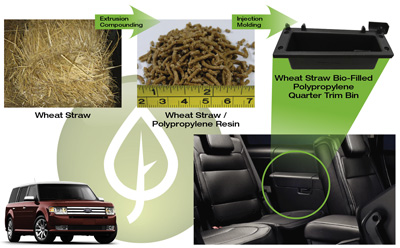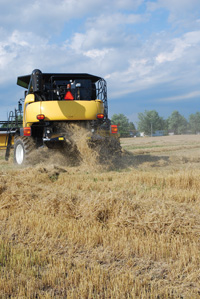
Features
Agronomy
Cereals
Spotlight on wheat straw
Moving into the second decade of the 21st century, one in which private companies and governments alike are extremely keen to develop fuels and other products from renewable sources, the importance of wheat straw will continue to grow.
August 13, 2010 By Treena Hein
Moving into the second decade of the 21st century, one in which private companies and governments alike are extremely keen to develop fuels and other products from renewable sources, the importance of wheat straw will continue to grow. Lightweight, strong, abundant and environmentally “sexy,” it represents a potential boon to everyone in the supply chain, from farmers on up.
 |
|
| Wheat straw is being processed, extruded and refined for use in interior storage bins in the 2010 Ford Flex sport utility vehicle. Photo courtesy of the Ford Motor Company. |
Six farmers in southern Ontario are successfully selling wheat straw that, after processing, becomes the star ingredient in the plastic used to make an interior storage bin in the 2010 Ford Flex. This reinforced resin not only demonstrates better dimensional integrity than a non-reinforced plastic, but weighs up to 10 percent less than a plastic reinforced with talc or glass. More than that, using 20 percent wheat straw to make these bins is estimated to reduce petroleum usage and associated CO2 emissions 30,000 pounds per year.
The new resin is the first production-ready application to come out of the Ontario BioCar Initiative, a partnership between the automotive industry and the public sector aimed at accelerating the use of biomass. It is a four-year project (2008 to 2011) funded by the Ontario Ministry of Research and Innovation, and involves researchers from the Ford Motor Company as well as the Universities of Waterloo, Guelph, Windsor and Toronto.
Dr. Leonardo Simon, a professor of chemical engineering at the University of Waterloo, is the principal researcher on the wheat-straw bin sub-project. “During the two years we were formulating this and applying for funding, we had to engage the industrial partners and create a supply chain for the materials we intended to create,” he explains. “Certainly wheat straw possesses attributes that make it suitable for use in plastics for the Ontario automotive industry. These include it being lightweight and strong and in close proximity to assembly plants. However, we needed to look closely at the needs of each tier of the supply chain to ensure there would be benefits for everyone to make this work.”
At the top of the supply chain sit the automakers, in this case, Ford. “A lightweight material certainly benefits an automaker such as Ford in terms of the fuel efficiency it provides,” says Simon. “Wheat straw is also renewable, which is advantageous in a marketing sense, but in addition, this product is especially environmentally friendly because it actually stores CO2 in the product.”
One step below are the “tier one” part-makers. “These companies make plastic auto parts through injection moulding,” explains Simon. “For them, wheat straw is beneficial to use in place of other materials because it requires a lower temperature of processing, which saves money.”
The “tier two” company is A. Schulman, which formulates the composite plastic itself and benefits from using wheat straw because it provides a lighter plastic, with no compromises for high-impact strength and stiffness. At “tier three” is Mississauga-based Omtec Inc., which processes the straw to a certain particle size to be used in the plastic. “They’ve done a lot of work in creating the methodology to process the wheat straw,” notes Simon. “They have also garnered a lot of knowledge about which part of the straw produces the best particles to make the best composite.” About 80 percent of the straw is from two varieties of wheat, Simon notes, and the variety has not been found to make a significant difference in this application.
At “tier four,” there are currently six Ontario farmers supplying Omtec. As demand grows, the company will look to source additional wheat straw based on production requirements. According to Omtec, although it is not possible to estimate total annual demand at this point, the potential demand is significant.
The price is based on whether the straw is purchased on the windrow versus already baled, and large rectangular bales are the best for efficient shipping. Simon says “We want to continue to bring more value to farmers. There is a lot of potential for on-farm pre-processing.”
Although the wheat straw-containing storage bins, which are black in colour, look no different than ones made of conventional material, “we have been investigating the feasibility and the customer opinion of emphasizing the natural look of the material to see some of the wheat straw fibre,” says Dr. Ellen Lee, Ford’s Plastics Research technical expert.
Ford is also considering the use of this bio-based plastic in numerous other interior, exterior and underbody applications in multiple vehicle lines. “An interior storage bin may seem like a small start, but it opens the door,” says Lee. “We see a great deal of potential for other applications, since wheat straw has good mechanical properties, can meet our performance and durability specifications, and can further-reduce our carbon footprint, all without compromise to the customer.”
Already under consideration are centre console bins and trays, interior air register and door-trim panel components, and armrest liners. Ford is also using soy-based polyurethane seat cushions, seatbacks and headliners, as well as post-industrial recycled yarns for seat fabrics, and post-consumer recycled resins for underbody systems, such as the new engine cam cover on the 2010 Ford Escape.
If there is a future requirement for stronger straw for composite plastic applications, “we will be able to address it fairly quickly and efficiently,” says Dr. Duane Falk, associate professor of plant agriculture at the University of Guelph, although he is not associated with the BioCar Initiative at this time. “We’ve been working on increasing straw strength in barley and have had quite good success by increasing the thickness of the straw walls through direct selection for this trait,” he says.
Simon is truly amazed at how fast this project has moved from the lab to industry. “It is very exciting,” he says. “The BioCar Initiative has allowed us to accelerate commercialization, which is very important.”
Beyond automotive
Wheat straw is also being incorporated into other products, including furniture and packaging. In May 2008, Canadian Geographic magazine made history when it published a special “wheat sheet” issue on paper made partially from wheat straw. Although the wheat straw pulp used in the paper had been imported from China, it was a first in North America; a result of four years of co-operative effort from project partners Canadian Geographic, the Alberta Research Council, Dollco Printing, NewPage and Canopy (formerly Markets Initiative), a Vancouver-based non-governmental organization that seeks to shift heavy paper-consuming sectors away from less-sustainable sources.

|
|
| More research is being done to establish a higher value for wheat straw and other crop residues. Photo by Ralph Pearce.
|
In the Canadian Geographic’s special issue, editor Rick Boychuk wrote, “Canadian farmers annually produce an estimated 21 million tonnes of wheat straw, which could be turned into eight million tonnes of pulp and enough paper for 20 million magazines.” Canopy representatives state that wheat straw yields three tonnes of fibre per hectare.
Canopy is hungry to take the next step; the organization stated in November 2009 that “last year’s successful trial with Canadian Geographic showed there is a future for a diversified paper fibre basket. China and India have known this for years, with more than 20 percent of the paper produced in those countries made from crops like wheat, rice straw and sugar cane bagasse. In North America, more than 300 book publishers, magazines and newspapers have committed to supporting the development and use of papers made from agricultural residues.” To develop this market, they are currently asking publishers to fill out an online survey.
If all this were not enough, in October 2009, the first wheat-straw building panels came off a factory production line in Yangling, China: panels that were designed and patented by scientists at the Alberta Research Council’s facility in Edmonton. ARC is an applied research and development corporation that commercializes technological products and services, many of which have a strong environmental focus. They have been perfecting these “oriented split straw board” construction panels, which are similar to wood-based oriented strand board (OSB) since the mid-1990s. It involved creating a machine to split the straw so that it lies flat for better bonding, and then creating methods to produce the panels themselves.
China’s huge appetite for alternative construction materials is fuelled by its lack of abundant wood. These wheat-straw panels are being produced because China does have lots of straw, which is commonly burned by the rural population for heating and cooking. In addition, ARC states that demand for housing in China has forced the excavation of food-producing land for clay brick-making, yet buildings that use brick and cement are susceptible to earthquakes. Wheat-straw panels provide a safer alternative, and to highlight this, a Chinese school that collapsed in a 2008 earthquake will be among the first buildings to be constructed with them. n
For more information:The Ontario BioCar Initiative: www.bioproductsatguelph.ca
Canopy “Wheat Sheet” information: canopyplanet.org/uploads/MI-wheatsheet3-screen.pdf
Farmers interested in selling straw to Omtec, call 905-614-1504 or visit www.omtecinc.ca